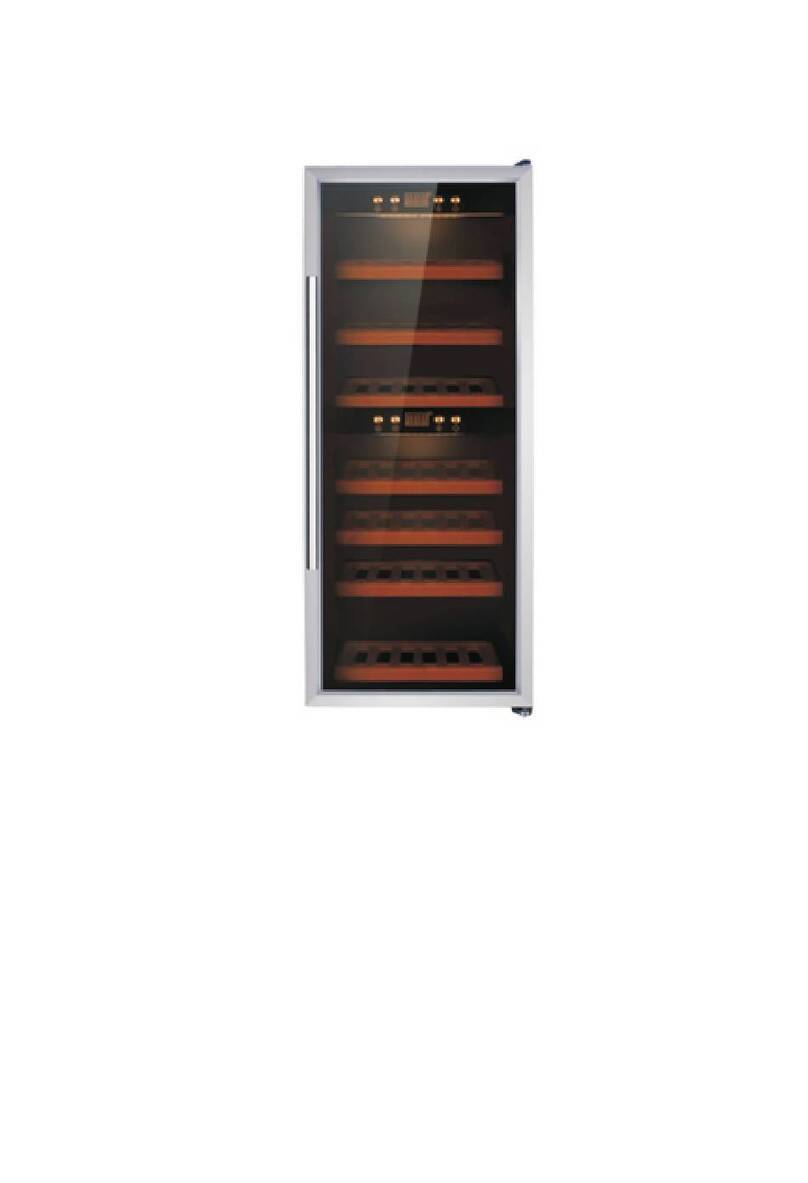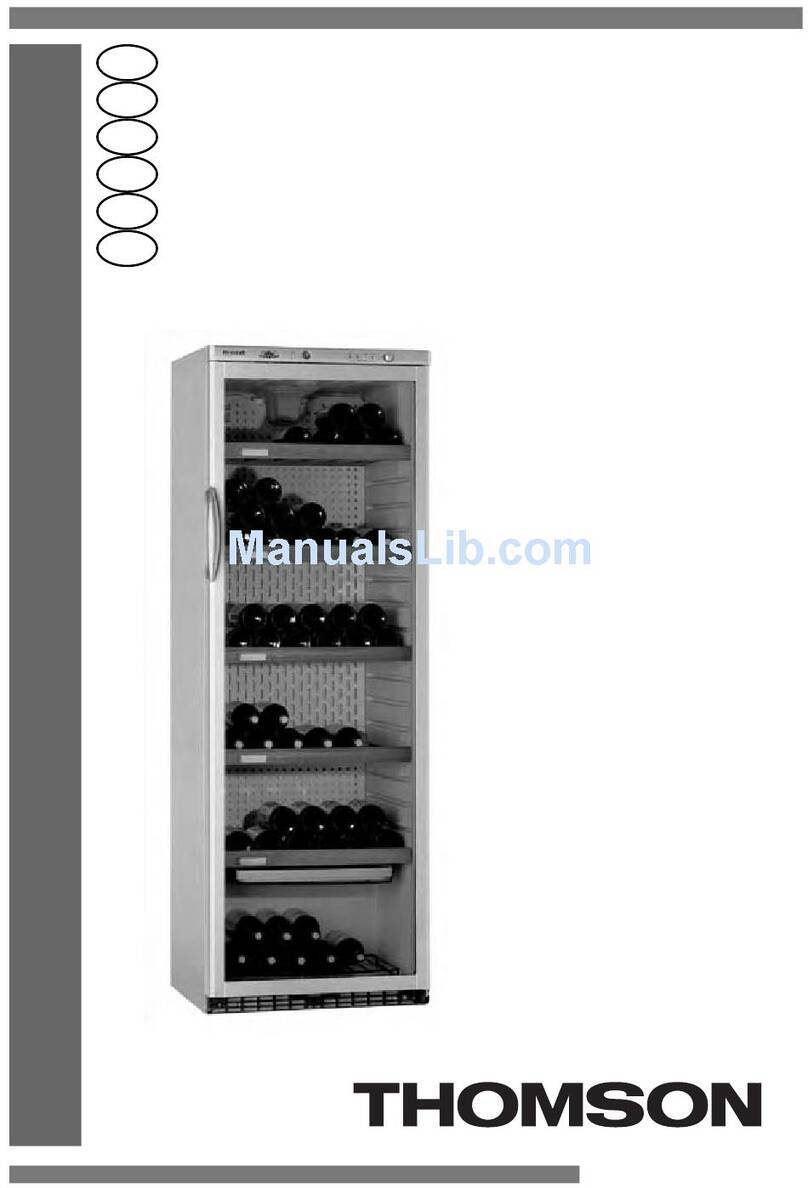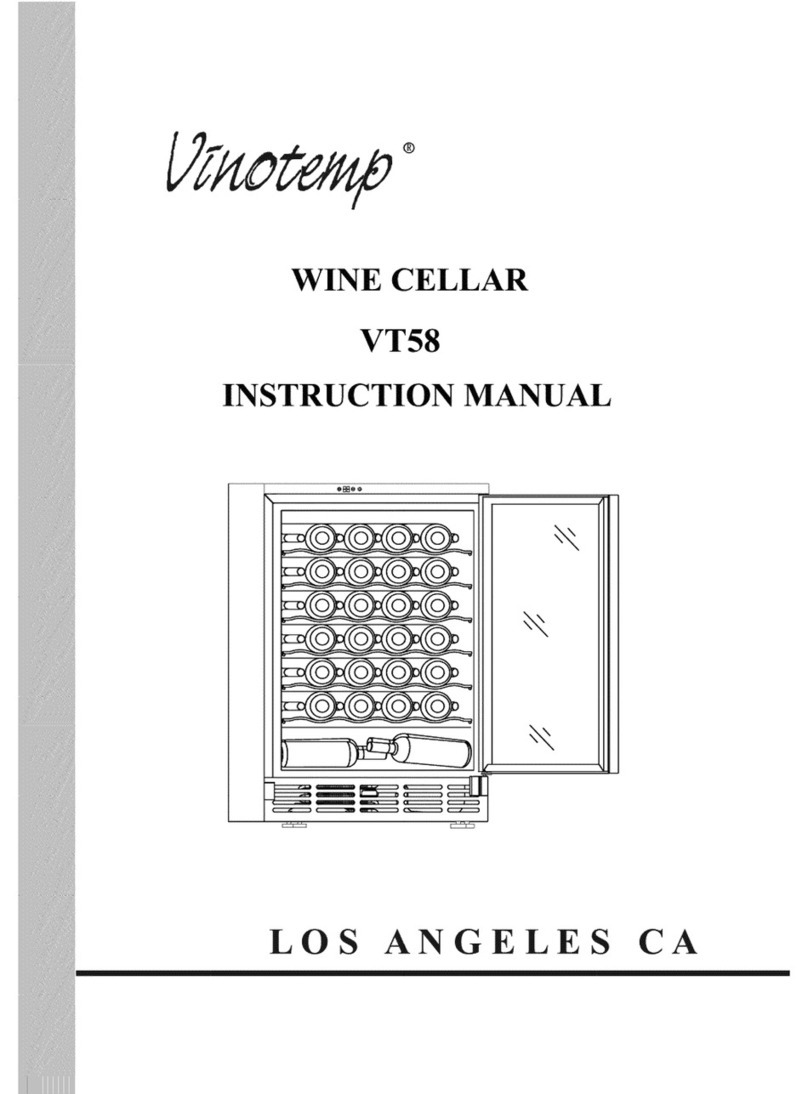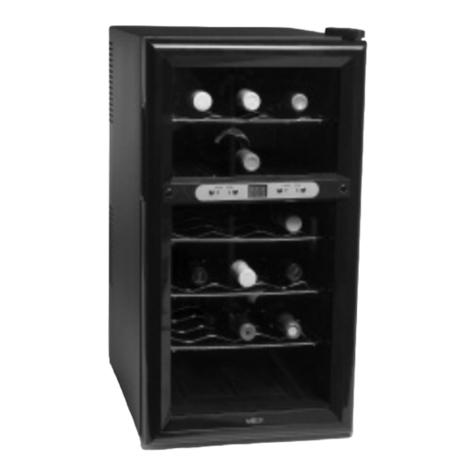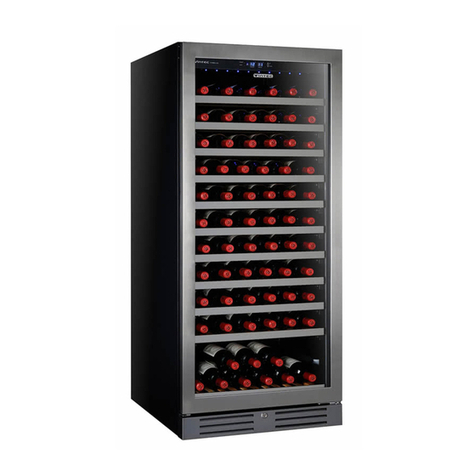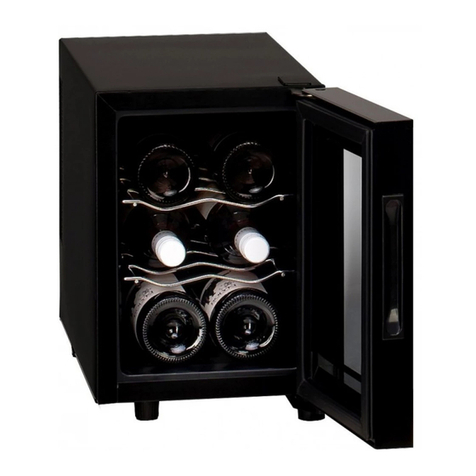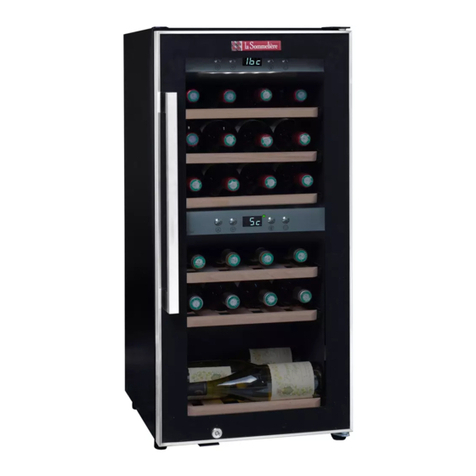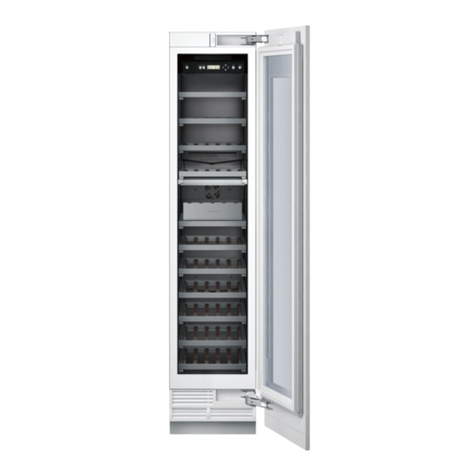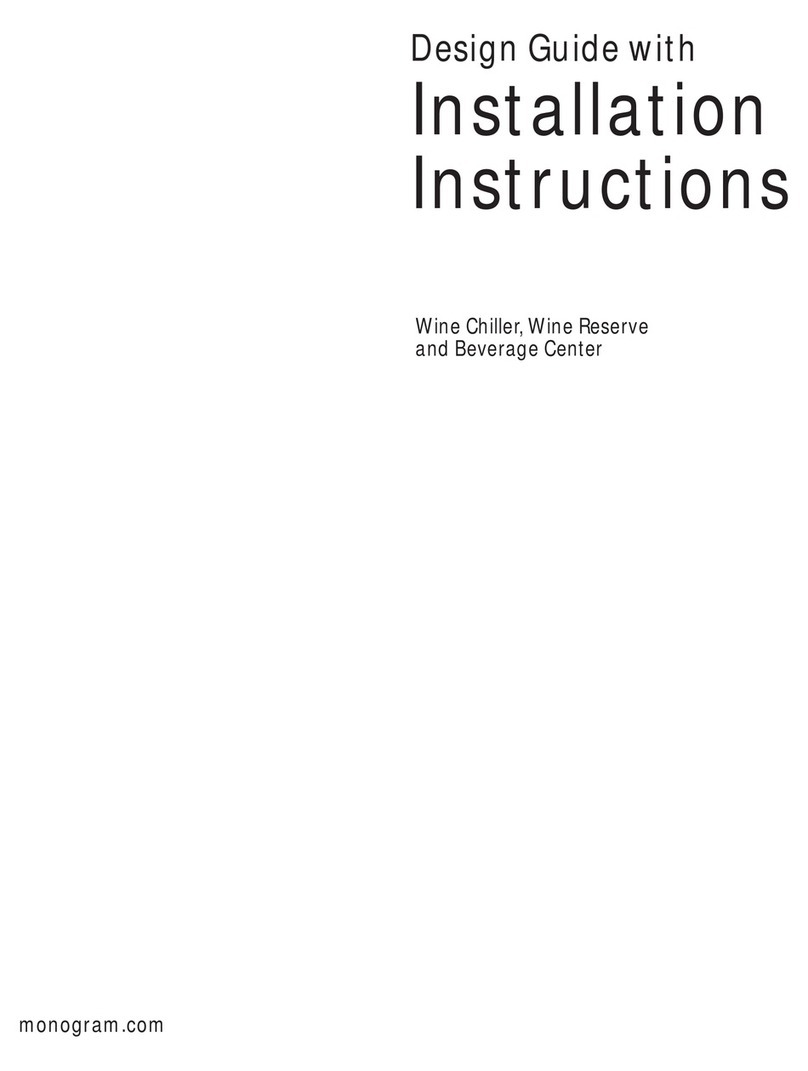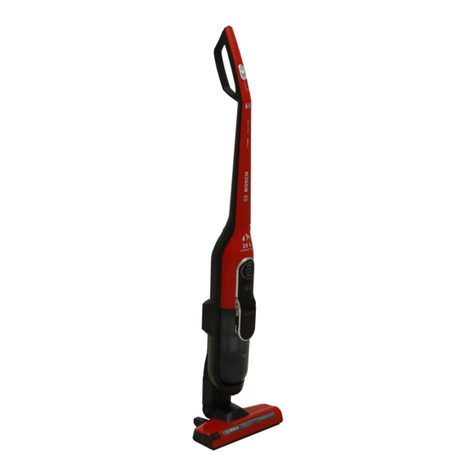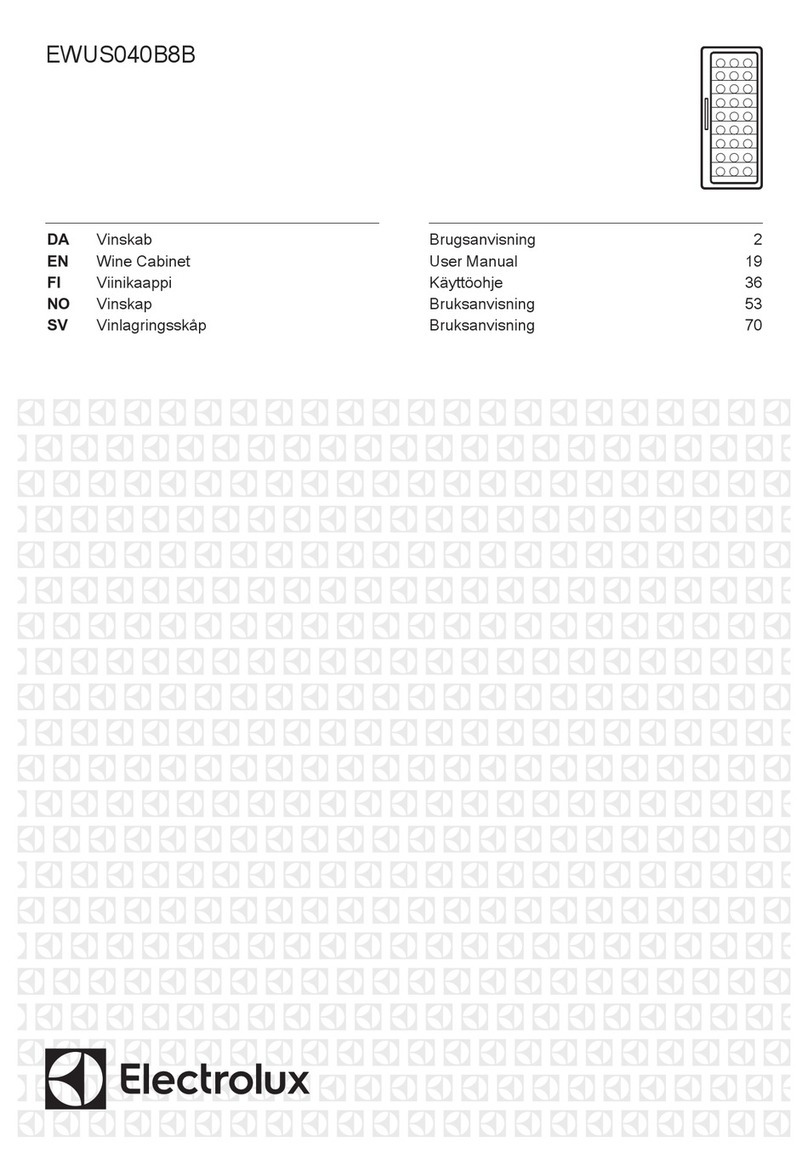Adexa JC-130E User manual

U S E R ‘ S M A N A U L - E N
Contents
Compressor Wine Cooler
JC-130E/HC

Important Safety Instruction ————————————————————— 1
Remove transport packaging —————————————————————3
Installation —————————————————————————————3
Description of the appliance —————————————————————-4
Defrosting —————————————————————————————--7
Cleaning and Care ——————————————————————————7
Energy Saving Tips —————————————————————————-9
Trouble shooting —————————————————————————-- 9
Changing the LED light ———————————————————————11
Power Supply————————————————————————————-11
Technical specifications———————————————————————-12
Wine cooler Circuit Diagram—————————————————————-13

1
Important Safety Instructions
These warnings are provided in the interests of your safety. Ensure you fully understand them
before installing or using the appliance.
Your safety is paramount importance. If you are unsure about the meaning of these warnings,
please contact the Customer Care Department for assistance.
Intended use
·The wine cooler is intended for use at home. It is suitable for the storing of wine at low
temperature. If the appliance is used for purposes other than those intended or used
incorrectly, no liability can be accepted by the manufacturer for any damage that may be
caused.
·Alterations or changes to the wine cooler are not permitted for reasons of safety.
If you use the wine cooler in a commercial application or for purposes other than the cooling
of foods, the manufacturer accepts no liability for any damages which may occurs.
Prior to initial start-up
·Check the appliance for transport damage. Under no circumstance should a damaged
appliance be plugged in. In the event of damage, please contact your supplier.
Wine cooler
The wine cooler is butane (R600a) is contained within the wine cooler circuit of the appliance, a
natural gas with a high level of environmental compatibility, which is nevertheless flammable
·During transportation and installation of the appliance, be certain that none of the
components of the wine cooler circuit become damaged.
·If the wine cooler circuit should become damaged: avoid opening flames and sources of
ignition;

2
thoroughly ventilate the room in which the appliance is situated.
·It is intended to be used exclusively for the storage of wine.
·This refrigerating appliances is not intended to be used as a built -in appliance.
. This refrigerating appliance is not suitable for freezing foodstuffs.
·The Wine Cooler is recommended to be designed at 12°C.
·The shelves are placed in factory mode that results in the most efficient use of energy for the
refrigerating appliances.
·Note: Setting the temperature too high can cause the wine to spoil, and setting the
temperature too low can waste electricity.
Safety of children
·Packaging (e.g. wraps, polystyrene) can be dangerous for children. There is a risk of
suffocation! Keep packaging material away from children!
·Make old appliances unusable prior to disposal. Pull out the main plug, cut off the mains cable,
break or remove spring or bolt catches, if fitted. By doing this you ensure that children
cannot lock themselves in the appliance when playing (there is risk of suffocation!) or get
themselves into other dangerous situations.
·Often children cannot recognize the hazards present in household appliances. It is therefore
important that you ensure adequate supervision and never let children play with the
appliance!
Daily Operation
·Containers with flammable gases or liquids can leak at low temperatures. There is a risk of an
explosion! Do not store any containers with flammable materials such as spray cans, fire

3
extinguisher refill cartridges etc in the wine cooler.
·Do not operate any electrical appliances in the wine cooler (e.g. electric ice cream makers,
mixers etc.).
·Before cleaning the appliance, always switch off the appliance and unplug it, or pull the house
fuse or switch off the circuit breaker.
·When unplugging always pull the plug from the mains socket, do not pull on the cable.
In case of malfunction
If a malfunction occurs on the appliance, please look first in the “Trouble shooting” section of
these instructions. If the information given there does not help, please do not perform any
further repairs yourself.
·Under no circumstance should you attempt to repair the appliance yourself. Repairs carried
out by inexperienced persons may cause injury or serious malfunctioning. Contact your local
Service Force Centre.
Remove transport packaging
The appliance and the interior fittings are protected for transport. Pull off the adhesive
tape on the left and right side of the door. You can remove any remnants of adhesive using
white spirit. Remove all adhesive tape and packing pieces from the interior of the Appliance.
Installation
Installation Location
The appliance should be set up in a well-ventilated, dry room. Energy use and efficient

4
performance of the appliance is affected by the ambient temperature. The appliance should
therefore not be exposed to direct sunlight; not be installed next to radiators, cookers or other
sources of heat; only be installed at a location whose ambient temperature corresponds to the
climate classification, for which the appliance is designed. The climate classification can be
found on the serial plate, which is located at the left on the inside of the appliance. The
appliance must be positioned so that the plug is accessible. The following table shows which
ambient temperature is correct for each climate classification:
If the wine cooler is installed next to another refrigerator or freezer a clearance of 5 cm at
the sides is required, in order to prevent the formation of condensation on the outside of the
appliance.
Your refrigerator needs air
For correct operation, this appliance must be located in a dry atmosphere, away from heat
sources, e.g. cookers, radiators, boilers and direct sunlight.
You should also ensure that air can circulate freely around the back and the top of the
cabinet.
Left and right :150mm
Back: 100mm
TOP: 100mm

5
Description of the appliance
View of the appliance
Mode: JC-130E
1
Glass Door
2
Wire shelf
3
Display
④
Door Hinge
⑤
Foot
⑥
Body of Wine cooler
Starting up and temperature regulation
5
4
6
2
1
3

6
When the power is connected, the cooling system starts to work. The temperature is
adjusted in the range of 4
℃
—18
℃
in the cabinet.
When you press the display control unit’
s
button, the LED display
number gradually diminish, last to “5
℃
”or “6
℃
” . When you press the display
control unit’
s
button, the LED display number gradually larger last to “18
℃
”. You
can set on certain position, which means that if the temperature in the wine-cooler reach the
point set, self-control temperature system stops cooling system so the temperature in the
cabinet rises gradually. When the inside temperature rises above the set point, Cooling
self-control temperature starts to work again.
You can
press
the
button then the display can change from Celsius(
℃
) to
Fahrenheit (
℉
).You can press
the
button, then the lamp can change from
lighten to go out.
If there is no button operation within about 12 seconds, the functions of setting
temperature and temperature display will not work. To unlock the two buttons, press and hold
and for about 5 seconds until a beep is heard. The you can change the
temperature setting and display.
Important!
High ambient temperatures (e.g. on hot summer days) and a cold setting on the
temperature to “5
℃
”or “6
℃
” can cause the compressor to run continuously.
Reason: when the ambient temperature is high, the compressor must run continuously to
maintain the low temperature in the appliance.
The wine cooler will not be able to defrost since automatic defrosting of the wine cooler is

7
only possible when the compressor is not running (see also “Defrosting” section). The result is
the building up of a thick layer of frost on the wine cooler rear wall. If this happens, turn the
temperature regulator back to a warmer setting “5
℃
”or “6
℃
” . At this setting the compressor
will be switched on and off as usual and automatic defrosting recommenced.
Defrosting
The Wine Cooler defrosts automatically
The rear wall of the Wine Cooler covers with frost when the compressor is running, and
defrosts when the compressor is off. The water from the thawing frost evaporates by itself.
Switching off the appliance
If the appliance is not going to be used for an extended period:
Remove all refrigerated packages.
Switch off the appliance by turning the temperature regulator to position“0”.
Remove the mains plug or switch off or disconnect the electricity supply.
Clean thoroughly (see section: leaning and Care)
Leave the door open to avoid the building up of odors.
Cleaning and Care
For hygienic reasons the appliance interior, including interior accessories, should be cleaned
regularly.
Warning!
The appliance should not be connected to the mains during cleaning. Danger of
electrical shock! Before cleaning switch the appliance off and remove the plug from the mains,

8
or switch off or turn out the circuit breaker or fuse.
If the appliance is not in use forever, do not throw it away freely, send it to recycle bin for
disposal. Never clean the appliance with a steam cleaner. Moisture could accumulate in
electrical components, danger of electrical shock! Hot vapors can lead to the damage of plastic
parts. The appliance must be dry before it is placed back into service.
Important!
Ethereal oils and organic solvents can attack plastic parts, e.g. lemon juice or the juice from
orange peel; butyric acid; cleanser which contain acetic acid.
Do not allow such substances to come into contact with appliance parts.
Do not use any abrasive cleansers.
Remove the bottles from the wine cooler. Store it in a cool place, well covered.
Switch the appliance off and remove the plug from the mains, or switch off or turn out the
circuit breaker or fuse.
Clean the appliance and the interior accessories with a cloth and lukewarm water.
Commercially available dish washing detergents may also be used.
After cleaning wipe with fresh water and rub dry.
Accumulation of dust at the condenser increases energy consumption.
For this reason carefully clean the condenser at the back of the appliance once a year with a
soft brush or a vacuum cleaner. Check the water drain hole on the rear wall of the wine cooler.
Clear a blocked drain hole with the aid of the green peg in the pack of accessories included
with the appliance.
After everything is dry place appliance back into service.

9
Energy Saving tips
Do not install the appliance near cookers, radiators or other sources of warmth. High ambient
temperatures cause longer, more frequent operation of the compressor.
Ensure sufficient air circulation and exhaust at the appliance base and at the back wall of the
appliance. Never cover air vent openings.
Only leave door open as long as necessary.
Do not set temperature any colder than necessary.
Keep the heat emitting condenser, the metal grille on the rear wall of your appliance, always
clean.
Trouble shooting
Correcting Malfunctions
A malfunction may be caused by only a minor fault that you can rectify yourself using the
following instructions. Do not perform any other work on the appliance if the following
information does not provide assistance in your specific case.
Important! Repairs to wine cooler may only be performed by competent service engineers.
Improper repairs can give rise to significant hazards for the user. If your appliance needs
repairing, please contact your specialist dealer or your local Service Force Centre.
①
When the wine cooler does not work.
Check if there is a power failure.
Check if the power plug is plugged into the power outlet.
Check that the fuse has not blown.
②
When the wine cooler is cooling excessively.

10
The temperature control dial may be set too high.
If you place bottles containing a lot of moisture directly under the cool air outlets, they will
freeze easily. This does not indicate a malfunction
③
When the wine cooler is not cooling sufficiently.
You may have put something hot or a lot of foodstuffs into the wine cooler.
The door may not have been closed properly.
The wine cooler may not be ventilated.
There may be insufficient clearance between the refrigerator and the surfaces immediately
both sides and above.
The temperature control dial may not be set properly.
④
When the defrosting water overflows inside the wine cooler and onto the floor.
check that the drain pipe and the drain hose are not clogged.
check that the drain pan is housed properly.
⑤
When the wine cooler’s cabinet front heats up.
in order to safeguard against condensation, there is an anti condensation, pipe which heats
up the cabinet front when running actuated. A war cabinet front does not indicate a
malfunction.
⑥
When condensation form on the outside of the wine cooler.
condensation may form on the outside when the humidity is high such as during a wet season.
This is the same result as the condensation formed when chilled water is poured into a glass.
It does not, therefore, indicate a failure, wipe dry with a dry cloth.
⑦
When you hear a sound like water flowing.
A sound like water flowing is the wine cooler flowing. It does not indicate a malfunction.

11
⑧
When the cabinet’s side panel heats up.
The side panel of the cabinet will heat up when the door is opened or closed frequently.
when starting the unit and when the unit operates in summer with high ambient outside
temperature. In such case, do not touch the panel, it results from the dissipation of the heat
from inside the cabinet, and it does not mean that something is wrong with the wine cooler.
Changing the LED light
Warning!
There is a risk of electric shocks! Before changing the light bulb , switch off the appliance and
unplug it, or pull the fuse or the circuit breaker.
LED Light Board data: AC220~240 V, max. 1W;
To switch off the appliance;
Unplug the mains plug.
Undo the screw.
Put down the LED Light Board cover .
Change the defective light bulb.
Refit the LED Light Board cover and the screw.
Put the wine cooler back into operation.
Power Supply
The wine cooler is only applied with power supply of single phase alternating current of
AC220-240
Ⅴ~
50Hz. lf fluctuation of voltage in the district user is of so large that the voltage
exceeds the above scope, for safety sake, be sure to apply A.C. automatic voltage regulator to

12
the wine cooler. The wine cooler must employ a special power socket instead of common one
with other electric appliances. Its plug must match the socket with ground wire.
Caution : do not use extension cord.
Power Line Cord
The cord should be neither lengthened nor folded into coil during operation . Moreover, it is
forbidden that cord is kept close onto the compressor at the back of the wine cooler, the
surface temperature of which is quite high when operating. Touching with it would deactivate
the insulation or cause leakage for electricity.
Technical specifications
Main technique data:
Model JC-130E/HC
Rated Voltage 220-240V AC
Rated Frequency 50Hz
Rated Current 0.55A
Volume 128L
Climate Type N,SN
Protection Type I
Refrigerant R600a (32g)
Insulation blowing gas Cyclopentane
Bottles 48 bottles « Bordeaux 75cl » size.
Specifications are subject to change without prior notice.
If the technical specifications are different from the plate at back of the wine cooler, please

13
refer to the plate.
Wine cooler Circuit Diagram
Warning; Risk of fire / flammable materials
WARNING: When positioning the appliance, ensure the supply cord is not trapped or damaged.
WARNING: Do not locate multiple portable socket-outlets or portable power supplies at the
rear of the appliance.
Children aged from 3 to 8 years are allowed to load and unload refrigerating appliances
The instructions shall contain details on the use of the appliance to ensure the safe
preservation of food stuffs.

14
To avoid contamination of food, please respect the following instructions
Opening the door for long periods can cause a significant increase of the temperature in the
compartments of the appliance.
If the refrigerating appliance is left empty for long periods, switch off, defrost, clean, dry, and
leave the door open to prevent mould developing within the appliance.
RECOMMENDED TEMPERATURE SETTINGS
The chart indicates the ideal storage temperatures for different types of wine:
Red Wines 15.5-18
℃
Dry/White Wines 10-15
℃
Sparkling Wines/champagne 7.2-9.5
℃
Rose Wines 9.5-10.5
℃
Vintage wine 13
℃
ENVIRONMENT-FRIENDLY DISPOSAL
The symbol above and on the product means that the product is classed as Electrical or

15
Electronic Equipment and should not be disposed of with household or commercial waste at the
end of its useful life. The Waste of Electrical and Electronic Equipment (WEEE) Directive
(2012/19/EU) was put in place to ensure that products are recycled using the
best available recovery
and recycling techniques, minimizing the impact on the environment, treating any hazardous
substances and avoiding the proliferation of landfill. Contact local authorities for information
on correct disposal of Electrical or Electronic Equipment.
This manual suits for next models
1
Table of contents
Other Adexa Wine Cooler manuals
